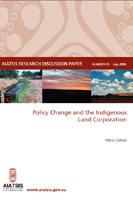Policy Change and the Indigenous Land Corporation
The Indigenous Land Corporation (ILC) was established in 1995 by the Keating Government as one element of its three-part response to the Mabo judgment. The first part was the Native Title Act (1993), which validated past grants of land to settlers and set up a process for claiming and registering surviving rights of native title. The second part was the creation of an Indigenous Land Fund, established by successive appropriations over ten years, after which it was to be self-sustaining. The ILC was set up at the same time to receive part of the allocation each year to buy alienated land for Indigenous groups. The third part of the Keating response, a Social Justice Package, was never implemented.
This discussion paper investigates changes in ILC policy from its inaugural period, when land was bought and divested to Indigenous groups rapidly, to the present day, when the ILC controls application procedures more tightly, divests under strict conditions, and augments its income from its own operations and investments. The paper suggests the ILC has shifted its focus from the direct benefit of land ownership towards joint programs with other government agencies for training, education and employment. The paper suggests this policy change has occurred without widespread consultation and communication, which has resulted in the dissatisfaction of Indigenous groups. The paper also discusses ILC finances, finding that it has faced considerable challenges since 2004 when it began funding itself entirely from the earnings of the Land Fund and its own investments. The paper concludes that it is time to review the purposes of the ILC and the Land Fund in the light of its original charter, and finds that its policies and strategies should be more inclusive and transparent.
